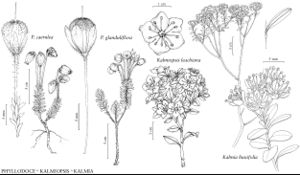Kalmia
Sp. Pl. 1: 391. 1753.
Gen. Pl. ed. 5, 185. 1754 ,.
Shrubs (rarely trees in K. latifolia). Stems erect, (branched and mat-forming in K. procumbens); twigs glabrous, puberulent, or stipitate-glandular, sometimes glabrescent. Leaves persistent (deciduous in K. cuneata), alternate, opposite, or in whorls of 3; petiole present; blade usually coriaceous, (base cuneate or obtuse), margins entire, (midvein abaxially glabrescent, puberulent, or glandular; buds flattened with 2 exposed, valvate to overlapping scales). Inflorescences axillary or terminal, racemes, umbels, panicles, or fascicles, 2–40-flowered, sometimes flowers solitary; perulae present. Flowers bisexual, radially symmetric; (calyx synsepalous, lobes deeply cleft), sepals (persistent, deciduous in K. hirsuta), (4–)5, (green or greenish), connate; petals 5, connate for nearly their entire lengths or distinct, corolla deciduous, sympetalous and saucer-shaped to polypetalous and campanulate, (tube extending into rotate, shallowly 5-cleft (deeply cleft in K. buxifolia, K. procumbens), commonly 10-keeled limb, limb with 10 saccate pockets in which anthers are held under tension, absent in K. buxifolia, K. procumbens); stamens 10 (5 in K. procumbens), included; (filaments usually hairy near base); anthers (usually purple), without awns, (ovoid), dehiscent by apical (or longitudinal) slits; ovary (2–)5-locular, (glabrous, stipitate-glandular in K. buxifolia); styles included, (straight or bent); stigma (5-lobed), capitate. Fruits capsular, (5-valved), subglobose to globose, dehiscence basipetally septicidal. Seeds ca. 100–150, obovoid, oblong, or ovoid, often winged, tailed; testa reticulate. x = 12.
Distribution
North America, West Indies (Cuba), n, c Europe, n Asia.
Discussion
Dendrium Desvaux; Kalmiella Small; Ledum Linnaeus sect. Leiophyllum Persoon; Leiophyllum (Persoon) R. Hedwig; Loiseleuria Desvaux
Species 10 (8 in the flora).
The inclusion here of Kalmia procumbens and K. buxifolia, traditionally treated as the monotypic genera Loiseleuria and Leiophyllum, is in keeping with the results of recent morphological and molecular phylogenetic studies. P. F. Stevens et al. (2004) also included Leiophyllum and Loiseleuria within an expanded Kalmia. These two species have evolved deeply cleft corollas with nearly separate petals, and thus lost the characteristic pockets of Kalmia; otherwise they are typical for the genus.
Kalmia has beautiful flowers that have long attracted the interests of horticulturists. It is economically important as an ornamental, with the most important species being K. angustifolia and K. latifolia (M. A. Dirr 1998; R. A. Jaynes 1988).
The mechanism of pollen discharge is a distinctive feature of most species of the genus, recognized since at least 1772 (A. Kress 1988). In anthesis, the anthers are snapped out of the pockets when insects disturb the bending filaments, dusting the insect body with pollen grains. Bumblebees (Bombus spp.) were found to be effective pollinators of Kalmia (J. E. Ebinger 1974).
In medicine, it is reported that Kalmia latifolia can be used as a cure for diarrhea and itching, the leaf powder as snuff, and K. hirsuta as a cure for itching and mange in dogs (R. A. Jaynes 1988). Kalmia latifolia has an antimicrobial effect (R. M. Heisey and B. K. Gorham 1992).
It is possible that all Kalmia species are poisonous to humans and livestock, and it is known that K. angustifolia, K. latifolia, K. microphylla, and K. polifolia are poisonous to livestock (B. S. Barton 1802; A. B. Clawson 1933; W. A. Dayton 1931; J. E. Ebinger 1974; R. A. Jaynes 1988; J. M. Kingsbury 1964; C. D. Marsh and A. B. Clawson 1930; W. C. Muenscher 1951). Sheep become sick when given leaves of K. angustifolia totalling as little as 0.15% of the animal body weight (Jaynes). The poisonous compound was identified as grayanotoxin I (andromedotoxin or acetyl-andromedol), a diterpene (J. W. Burke and R. W. Doskotch 1990; S. D. Mancini and J. M. Edwards 1979).
Selected References
Lower Taxa
Key
| 1 | Petals distinct nearly their entire lengths. | Kalmia buxifolia |
| 1 | Petals connate ca. 1/2 to nearly their entire lengths | > 2 |
| 2 | Leaves opposite; inflorescences terminal, corymbiform racemes or umbels | > 3 |
| 2 | Leaves alternate (rarely opposite) or in whorls; inflorescences solitary flowers or fascicles, racemes, or panicles | > 5 |
| 3 | Midribs of leaf blades with purple, clavate trichomes; seeds 1.5-2.2 mm. | Kalmia polifolia |
| 3 | Midribs of leaf blades without trichomes; seeds 0.5-1.4 mm | > 4 |
| 4 | Capsules 5-locular; petals 7-9 mm, shallowly cleft; stamens 10. | Kalmia microphylla |
| 4 | Capsules 2-3-locular; petals 3-5 mm, cleft ca. 1/2 their lengths; stamens 5. | Kalmia procumbens |
| 5 | Leaves usually in whorls of 3 (rarely alternate or opposite) | Kalmia angustifolia |
| 5 | Leaves alternate or seemingly whorled | > 6 |
| 6 | Leaves deciduous; petals white with red band adaxially. | Kalmia cuneata |
| 6 | Leaves persistent; petals white to pink or red | > 7 |
| 7 | Plants 8(-12) m; leaf blade surfaces glabrous adaxially (only midrib puberulent), 4-12 cm; inflorescences terminal panicles | Kalmia latifolia |
| 7 | Plants 0.6(-1.2) m; leaf blade surfaces usually hairy, 0.5-1.4 cm; inflorescences solitary flowers or, sometimes, fascicles or racemes, scattered along stem in leaf axils. | Kalmia hirsuta |
